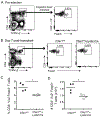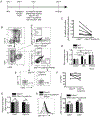C5aR1 regulates migration of suppressive myeloid cells required for costimulatory blockade-induced murine allograft survival
- PMID: 30106232
- PMCID: PMC6375810
- DOI: 10.1111/ajt.15072
C5aR1 regulates migration of suppressive myeloid cells required for costimulatory blockade-induced murine allograft survival
Abstract
Costimulatory blockade-induced murine cardiac allograft survival requires intragraft accumulation of CD11b+ Ly6Clo Ly6G- regulatory myeloid cells (Mregs) that expand regulatory T cells (Tregs) and suppress effector T cells (Teffs). We previously showed that C5a receptor (C5aR1) signaling on T cells activates Teffs and inhibits Tregs, but whether and/or how C5aR1 affects Mregs required for transplant survival is unknown. Although BALB/c hearts survived >60 days in anti-CD154 (MR1)-treated or cytotoxic T-lymphocyte associated protein 4 (CTLA4)-Ig-treated wild-type (WT) recipients, they were rejected at ~30 days in MR1-treated or CTLA4-Ig-treated recipients selectively deficient in C5aR1 restricted to myeloid cells (C5ar1fl/fl xLysM-Cre). This accelerated rejection was associated with ~2-fold more donor-reactive T cells and ~40% less expansion of donor-reactive Tregs. Analysis of graft-infiltrating mononuclear cells on posttransplant day 6 revealed fewer Ly6Clo monocytes in C5ar1fl/fl xLysM-Cre recipients. Expression profiling of intragraft Ly6Clo monocytes showed that C5aR1 deficiency downregulated genes related to migration/locomotion without changes in genes associated with suppressive function. Cotransfer of C5ar1fl/fl and C5ar1fl/fl xLysM-Cre myeloid cells into MR1-treated allograft recipients resulted in less accumulation of C5ar1-/- cells within the allografts, and in vitro assays confirmed that Ly6Chi myeloid cells migrate to C5a/C5aR1-initiated signals. Together, our results newly link myeloid cell-expressed C5aR1 to intragraft accumulation of myeloid cells required for prolongation of heart transplant survival induced by costimulatory blockade.
Keywords: animal models: murine; basic (laboratory) research/science; immunobiology; immunosuppression/immune modulation; macrophage/monocyte biology; macrophage/monocyte biology: trafficking; tolerance: experimental.
© 2018 The American Society of Transplantation and the American Society of Transplant Surgeons.
Conflict of interest statement
Disclosure
The authors of this manuscript have no conflicts of interest to disclose as described by the
Figures







Comment in
-
C5aR1 governs Mreg migration, development, and function.Am J Transplant. 2019 Mar;19(3):619-621. doi: 10.1111/ajt.15153. Epub 2018 Nov 26. Am J Transplant. 2019. PMID: 30372590 No abstract available.
Similar articles
-
Complement Dependence of Murine Costimulatory Blockade-Resistant Cellular Cardiac Allograft Rejection.Am J Transplant. 2017 Nov;17(11):2810-2819. doi: 10.1111/ajt.14328. Epub 2017 May 30. Am J Transplant. 2017. PMID: 28444847 Free PMC article.
-
Macrophage subpopulations and their impact on chronic allograft rejection versus graft acceptance in a mouse heart transplant model.Am J Transplant. 2018 Mar;18(3):604-616. doi: 10.1111/ajt.14543. Epub 2017 Nov 23. Am J Transplant. 2018. PMID: 29044999 Free PMC article.
-
Role of STAT4 and STAT6 signaling in allograft rejection and CTLA4-Ig-mediated tolerance.J Immunol. 2000 Nov 15;165(10):5580-7. doi: 10.4049/jimmunol.165.10.5580. J Immunol. 2000. PMID: 11067913
-
Donor-Derived Regulatory Dendritic Cell Infusion Maintains Donor-Reactive CD4+CTLA4hi T Cells in Non-Human Primate Renal Allograft Recipients Treated with CD28 Co-Stimulation Blockade.Front Immunol. 2018 Feb 19;9:250. doi: 10.3389/fimmu.2018.00250. eCollection 2018. Front Immunol. 2018. PMID: 29520267 Free PMC article.
-
CTLA4-Ig plus bone marrow induces long-term allograft survival and donor specific unresponsiveness in the murine model. Evidence for hematopoietic chimerism.Transplantation. 1996 Apr 15;61(7):997-1004. doi: 10.1097/00007890-199604150-00002. Transplantation. 1996. PMID: 8623206
Cited by
-
Complement and Cancer-A Dysfunctional Relationship?Antibodies (Basel). 2020 Nov 5;9(4):61. doi: 10.3390/antib9040061. Antibodies (Basel). 2020. PMID: 33167384 Free PMC article. Review.
-
Adaptive features of innate immune cells and their relevance to graft rejection.Curr Opin Organ Transplant. 2019 Dec;24(6):664-669. doi: 10.1097/MOT.0000000000000707. Curr Opin Organ Transplant. 2019. PMID: 31577598 Free PMC article. Review.
-
Targeting Macrophages in Organ Transplantation: A Step Toward Personalized Medicine.Transplantation. 2024 Oct 1;108(10):2045-2056. doi: 10.1097/TP.0000000000004978. Epub 2024 Mar 12. Transplantation. 2024. PMID: 38467591 Review.
-
Complement-targeted therapies in kidney transplantation-insights from preclinical studies.Front Immunol. 2022 Oct 13;13:984090. doi: 10.3389/fimmu.2022.984090. eCollection 2022. Front Immunol. 2022. PMID: 36311730 Free PMC article. Review.
-
Innate immune cellular therapeutics in transplantation.Front Transplant. 2023;2:1067512. doi: 10.3389/frtra.2023.1067512. Epub 2023 Mar 31. Front Transplant. 2023. PMID: 37994308 Free PMC article.
References
-
- Larsen CP, Elwood ET, Alexander DZ, Ritchie SC, Hendrix R, Tucker-Burden C et al. Long-term acceptance of skin and cardiac allografts after blocking CD40 and CD28 pathways. Nature 1996;381(6581):434–438. - PubMed
-
- Ochando JC, Homma C, Yang Y, Hidalgo A, Garin A, Tacke F et al. Alloantigen-presenting plasmacytoid dendritic cells mediate tolerance to vascularized grafts. Nat Immunol 2006;7(6):652–662. - PubMed
-
- Pearson TC, Trambley J, Odom K, Anderson DC, Cowan S, Bray R et al. Anti-CD40 therapy extends renal allograft survival in rhesus macaques. Transplantation 2002;74(7):933–940. - PubMed
Publication types
MeSH terms
Substances
Grants and funding
LinkOut - more resources
Full Text Sources
Other Literature Sources
Medical
Molecular Biology Databases
Research Materials

